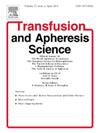Efficiency and safety of granulocyte colony-stimulating factor combined with plerixafor for autologous peripheral blood hematopoietic stem cell mobilization in light chain amyloidosis
IF 1.2
4区 医学
Q4 HEMATOLOGY
引用次数: 0
Abstract
Autologous stem cell transplantation (ASCT) is one of the standard treatments for light chain (AL) amyloidosis, and the mobilization of peripheral blood hematopoietic stem cell (PBHSC) is crucial for transplantation. Plerixafor has been shown to promote stem cell mobilization. The retrospective study included 56 patients who underwent ASCT. Twenty-eight patients received G-CSF combined with plerixafor (G+P), and the other 28 patients received G-CSF based stem cell mobilization (G). All patients finally achieved the minimum collection requirements, but there was no statistical difference in the total CD34 + cells yield between the two groups (p = 0.74). The number of patients achieving the minimum goal, peripheral blood CD34 + cells count, product CD34 + cells count, and CD34 + cells yield of the first apheresis day were higher in the group G+P compared with the group G (28 vs 21, p = 0.02; 106 cells/μL vs 38 cells/μL, p < 0.01; 1880 cells/μL vs 936 cells/μL, p < 0.01; 5.6 × 106 cells/kg vs 3.3 × 106 cells/kg, p < 0.01). All perimobilization adverse events were grade 1–2 and no mortality was observed. In conclusion, G-CSF combined with plerixafor mobilization is effective and safe in patients with AL amyloidosis.
粒细胞集落刺激因子联合百利沙对轻链淀粉样变性患者自体外周血造血干细胞动员的有效性和安全性
自体干细胞移植(ASCT)是轻链(AL)淀粉样变性的标准治疗方法之一,外周血造血干细胞(PBHSC)的动员是移植的关键。Plerixafor已被证明可以促进干细胞的动员。回顾性研究包括56例接受ASCT的患者。28例患者接受G- csf联合plerixafor (G+P)治疗,28例患者接受基于G- csf的干细胞动员(G)治疗。所有患者最终均达到最低收集要求,但两组间CD34 + 细胞总产量无统计学差异(p = 0.74)。G+P组达到最低目标的患者数、外周血CD34 + 细胞计数、产物CD34 + 细胞计数、首采日CD34 + 细胞产量均高于G组(28 vs 21, P = 0.02;106 cells/μL vs 38 cells/μL, p <; 0.01;1880 cells/μL vs 936 cells/μL, p <; 0.01;5.6 × 106 cells/kg vs 3.3 × 106 cells/kg, p <; 0.01)。所有围活动期不良事件均为1-2级,无死亡。综上所述,G-CSF联合百立沙对AL淀粉样变性患者是安全有效的。
本文章由计算机程序翻译,如有差异,请以英文原文为准。
求助全文
约1分钟内获得全文
求助全文
来源期刊
CiteScore
3.60
自引率
5.30%
发文量
181
审稿时长
42 days
期刊介绍:
Transfusion and Apheresis Science brings comprehensive and up-to-date information to physicians and health care professionals involved in the rapidly changing fields of transfusion medicine, hemostasis and apheresis. The journal presents original articles relating to scientific and clinical studies in the areas of immunohematology, transfusion practice, bleeding and thrombotic disorders and both therapeutic and donor apheresis including hematopoietic stem cells. Topics covered include the collection and processing of blood, compatibility testing and guidelines for the use of blood products, as well as screening for and transmission of blood-borne diseases. All areas of apheresis - therapeutic and collection - are also addressed. We would like to specifically encourage allied health professionals in this area to submit manuscripts that relate to improved patient and donor care, technical aspects and educational issues.
Transfusion and Apheresis Science features a "Theme" section which includes, in each issue, a group of papers designed to review a specific topic of current importance in transfusion and hemostasis for the discussion of topical issues specific to apheresis and focuses on the operators'' viewpoint. Another section is "What''s Happening" which provides informal reporting of activities in the field. In addition, brief case reports and Letters to the Editor, as well as reviews of meetings and events of general interest, and a listing of recent patents make the journal a complete source of information for practitioners of transfusion, hemostasis and apheresis science. Immediate dissemination of important information is ensured by the commitment of Transfusion and Apheresis Science to rapid publication of both symposia and submitted papers.

 求助内容:
求助内容: 应助结果提醒方式:
应助结果提醒方式:


